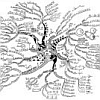| |
   
Gabriel Cardona,
Mercè Llabrés,
Francesc Rosselló and
Gabriel Valiente. The comparison of tree-sibling time consistent phylogenetic networks is graph-isomorphism complete. In The Scientific World Journal, Vol. 2014(254279):1-6, 2014.
Keywords: abstract network, distance between networks, from network, isomorphism, phylogenetic network, tree sibling network.
Note: http://arxiv.org/abs/0902.4640.
Toggle abstract
"Several polynomial time computable metrics on the class of semibinary tree-sibling time consistent phylogenetic networks are available in the literature; in particular, the problem of deciding if two networks of this kind are isomorphic is in P. In this paper, we show that if we remove the semibinarity condition, then the problem becomes much harder. More precisely, we prove that the isomorphism problem for generic tree-sibling time consistent phylogenetic networks is polynomially equivalent to the graph isomorphism problem. Since the latter is believed not to belong to P, the chances are that it is impossible to define a metric on the class of all tree-sibling time consistent phylogenetic networks that can be computed in polynomial time. © 2014 Gabriel Cardona et al."
|
|
| |
 
Jesper Jansson and
Andrzej Lingas. Computing the rooted triplet distance between galled trees by counting triangles. In Journal of Discrete Algorithms, Vol. 25:66-78, 2014.
Keywords: distance between networks, explicit network, from network, galled network, phylogenetic network, phylogeny, polynomial, triplet distance.
Toggle abstract
"We consider a generalization of the rooted triplet distance between two phylogenetic trees to two phylogenetic networks. We show that if each of the two given phylogenetic networks is a so-called galled tree with n leaves then the rooted triplet distance can be computed in o(n2.687) time. Our upper bound is obtained by reducing the problem of computing the rooted triplet distance between two galled trees to that of counting monochromatic and almost-monochromatic triangles in an undirected, edge-colored graph. To count different types of colored triangles in a graph efficiently, we extend an existing technique based on matrix multiplication and obtain several new algorithmic results that may be of independent interest: (i) the number of triangles in a connected, undirected, uncolored graph with m edges can be computed in o(m1.408) time; (ii) if G is a connected, undirected, edge-colored graph with n vertices and C is a subset of the set of edge colors then the number of monochromatic triangles of G with colors in C can be computed in o(n2.687) time; and (iii) if G is a connected, undirected, edge-colored graph with n vertices and R is a binary relation on the colors that is computable in O(1) time then the number of R-chromatic triangles in G can be computed in o(n2.687) time. © 2013 Elsevier B.V. All rights reserved."
|
|
| |

Ward C Wheeler. Phyletic groups on networks. In Cladistics, Vol. 30(4):447-451, 2014.
Keywords: explicit network, from network, phylogenetic network, phylogeny.
Note: http://dx.doi.org/10.1111/cla.12062.
Toggle abstract
"Three additional phyletic group types, "periphyletic," "epiphyletic", and "anaphyletic" (in addition to Hennigian mono-, para-, and polyphyletic) are defined in terms of trees and phylogenetic networks (trees with directed reticulate edges) via a generalization of the algorithmic definitions of Farris. These designations concern groups defined as monophyletic on trees, but with additional gains or losses of members from network edges. These distinctions should be useful in discussion of systems with non-vertical inheritance such as recombination between viruses, horizontal exchange between bacteria, hybridization in plants and animals, as well as human linguistic evolution. Examples are illustrated with Indo-European language groups. © The Willi Hennig Society 2013."
|
|
| |
 
Lavanya Kannan and
Ward C Wheeler. Exactly Computing the Parsimony Scores on Phylogenetic Networks Using Dynamic Programming. In JCB, Vol. 21(4):303-319, 2014.
Keywords: explicit network, exponential algorithm, from network, from sequences, parsimony, phylogenetic network, phylogeny, reconstruction.
Toggle abstract
"Scoring a given phylogenetic network is the first step that is required in searching for the best evolutionary framework for a given dataset. Using the principle of maximum parsimony, we can score phylogenetic networks based on the minimum number of state changes across a subset of edges of the network for each character that are required for a given set of characters to realize the input states at the leaves of the networks. Two such subsets of edges of networks are interesting in light of studying evolutionary histories of datasets: (i) the set of all edges of the network, and (ii) the set of all edges of a spanning tree that minimizes the score. The problems of finding the parsimony scores under these two criteria define slightly different mathematical problems that are both NP-hard. In this article, we show that both problems, with scores generalized to adding substitution costs between states on the endpoints of the edges, can be solved exactly using dynamic programming. We show that our algorithms require O(mpk) storage at each vertex (per character), where k is the number of states the character can take, p is the number of reticulate vertices in the network, m = k for the problem with edge set (i), and m = 2 for the problem with edge set (ii). This establishes an O(nmpk2) algorithm for both the problems (n is the number of leaves in the network), which are extensions of Sankoff's algorithm for finding the parsimony scores for phylogenetic trees. We will discuss improvements in the complexities and show that for phylogenetic networks whose underlying undirected graphs have disjoint cycles, the storage at each vertex can be reduced to O(mk), thus making the algorithm polynomial for this class of networks. We will present some properties of the two approaches and guidance on choosing between the criteria, as well as traverse through the network space using either of the definitions. We show that our methodology provides an effective means to study a wide variety of datasets. © Copyright 2014, Mary Ann Liebert, Inc. 2014."
|
|
| |
    
Kevin J. Liu,
Jingxuan Dai,
Kathy Truong,
Ying Song,
Michael H. Kohn and
Luay Nakhleh. An HMM-Based Comparative Genomic Framework for Detecting Introgression in Eukaryotes. In PLoS ONE, Vol. 10(6):e1003649, 2014.
Keywords: explicit network, from network, phylogenetic network, phylogeny, Program PhyloNet-HMM.
Note: http://arxiv.org/abs/1310.7989.
Toggle abstract
"One outcome of interspecific hybridization and subsequent effects of evolutionary forces is introgression, which is the integration of genetic material from one species into the genome of an individual in another species. The evolution of several groups of eukaryotic species has involved hybridization, and cases of adaptation through introgression have been already established. In this work, we report on PhyloNet-HMM-a new comparative genomic framework for detecting introgression in genomes. PhyloNet-HMM combines phylogenetic networks with hidden Markov models (HMMs) to simultaneously capture the (potentially reticulate) evolutionary history of the genomes and dependencies within genomes. A novel aspect of our work is that it also accounts for incomplete lineage sorting and dependence across loci. Application of our model to variation data from chromosome 7 in the mouse (Mus musculus domesticus) genome detected a recently reported adaptive introgression event involving the rodent poison resistance gene Vkorc1, in addition to other newly detected introgressed genomic regions. Based on our analysis, it is estimated that about 9% of all sites within chromosome 7 are of introgressive origin (these cover about 13 Mbp of chromosome 7, and over 300 genes). Further, our model detected no introgression in a negative control data set. We also found that our model accurately detected introgression and other evolutionary processes from synthetic data sets simulated under the coalescent model with recombination, isolation, and migration. Our work provides a powerful framework for systematic analysis of introgression while simultaneously accounting for dependence across sites, point mutations, recombination, and ancestral polymorphism. © 2014 Liu et al."
|
|
|
 - forked on GitHub.
- forked on GitHub.

































































































